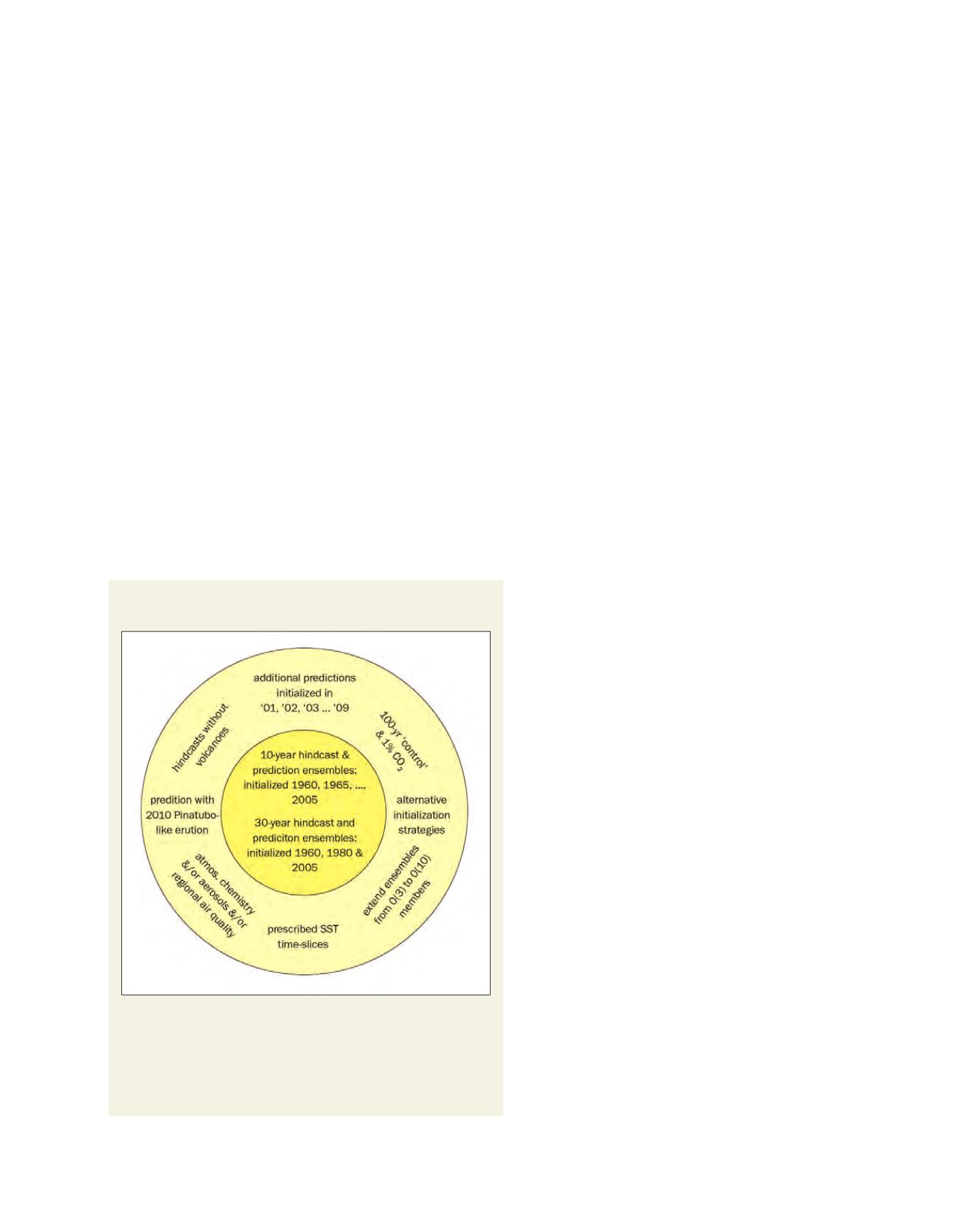

[
] 177
O
bserving
, P
redicting
and
P
rojecting
C
limate
C
onditions
climate models will incorporate the carbon cycle, specified/simple
chemistry and aerosols. These models will be forced by new mitiga-
tion scenarios referred to as ‘representative concentration pathways’.
Mitigation and adaptation scenarios with permissible emission levels
that allow the system to reach gradually targeted concentration are to
be used (in place of the previous IPCC Special Report on Emissions
Scenarios). The new scenarios will have implicit policy actions to
target future levels of climate change.
Since we can only mitigate part of the problem, the challenge is to
use climate models to quantify time-evolving regional climate changes
to which human societies will have to adapt. A new focus area for
CMIP5 is a set of near-term projections that encompass 10- and
30-year prediction studies and high-resolution time slice experi-
ments.
2
WCRP researchers believe there are reasonable prospects for
producing decadal forecasts of sufficient skill to be used by planners
and decision makers. There are two aspects to the decadal problem,
the externally forced signal, and the predictable part of the internally
generated signal. The latter signal comes from intrinsic oceanic mech-
anisms, coupled ocean atmosphere processes, modulation of climate
modes of variability (for example, the El Niño/Southern Oscillation)
and – potentially – land and cryospheric processes.
The WCRP will continue to support the quadrennial WMO/United
Nations Environment Programme Ozone Assessment. The SPARC
Chemistry Climate Model Validation Activity (CCMVal) is the main
model-based analysis for the connection between atmospheric chem-
istry and climate. CCMVal provides strategic modelling
support to the ozone assessment process, which is
mandated by the Montreal Protocol. Ozone is a major
constituent in radiative processes and is also affected
by dynamics and transport. Only CCMs can simulate
the feedback of chemical processes on the dynamics
and transport of trace gases. The CCM simulations
are designed to support the WMO/UNEP Scientific
Assessment of Ozone Depletion/Recovery: 2010. The
main focus will lie on model validation against observa-
tions, as well as on assessments of the future development
of stratospheric ozone.
At present, ozone recovery is expected to take place
until the middle of the century,
3
when column ozone
is expected to reach 1980 values in southern polar lati-
tudes. This development is determined, on the one hand,
by a decrease in ozone depleting substances (ODSs) and
on the other by a decrease in stratospheric tempera-
tures – due to enhanced greenhouse gas concentrations
in the atmosphere, which affects polar stratospheric
cloud formation and heterogeneous ozone destruction.
An important issue is how changes in the tropospheric
abundances of ODSs translate to changes in the ozone-
depleting active chemicals in the stratosphere. For
studies of the future development of stratospheric ozone
it is of great importance to take into account interactions
between radiation, dynamics and the chemical composi-
tion of the entire atmosphere.
To date, climate projections have generally treated
internal variability as a statistical component of uncer-
tainty. Though there is no marked decadal peak in the
spectrum of the climate system, long timescales exist
and are potentially predictable. The challenge of predic-
tion/predictability studies is to identify the mechanisms
associated with regions/modes of predictability, to better
understand the connection between oceanic modes and
terrestrial climate variability, and to investigate predic-
tive skill by means of prognostic (including multi-model)
decadal predictions. The results of predictability studies
and demonstrations of forecast skill provide the founda-
tions for initiating a coordinated WCRP study of decadal
climate variability, predictability and prediction.
In summary, the WCRP has made great strides in
advancing understanding of the coupled climate system
from seasonal to centennial timescales. WCRP research
efforts formed the foundation of today’s seasonal climate
forecasting products and services. The WCRP has played
a major role in converting the resultant scientific infor-
mation and knowledge about the Earth’s climate system
for use in policy decisions. This has been achieved via
the IPCC, the UNFCCC Conference of Parties and its
Subsidiary Body on Scientific and Technological Advice.
More than half of the scientific and technical contribu-
tions used in the IPCC assessments were provided by
WCRP-affiliated scientists.
The WCRP has made a concerted effort to provide
worldwide access to its model predictions/projections
and research results. With such access scientists from
developing and least developed countries are able to assess
CMIP5 Decadal Predictability/Prediction Experiments. Draft from
WGCM meeting, September 2008
WCRP and the International Geosphere-Biosphere Programme combined their
expertise to advance climate model development and, hence, prediction capabilities.
By incorporating the more complex Earth system processes, models are also being
tested for their response to different forcings. Within the WCRP, the Working Group on
Coupled Modeling leads the development of coupled ocean-atmosphere-land models
used for climate studies on decadal and longer timescales
Source: Taylor et al. (2008)
















